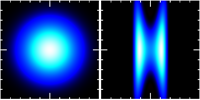Abstract
The ability to engineer both linear and nonlinear coupling with a mechanical resonator is an important goal for the preparation and investigation of macroscopic mechanical quantum behavior. In this work, a measurement based scheme is presented where linear or square mechanical-displacement coupling can be achieved using the optomechanical interaction that is linearly proportional to the mechanical position. The resulting square-displacement measurement strength is compared to that attainable in the dispersive case that has a direct interaction with the mechanical-displacement squared. An experimental protocol and parameter set are discussed for the generation and observation of non-Gaussian states of motion of the mechanical element.
- Received 3 June 2011
DOI:https://doi.org/10.1103/PhysRevX.1.021011
This article is available under the terms of the Creative Commons Attribution 3.0 License. Further distribution of this work must maintain attribution to the author(s) and the published article’s title, journal citation, and DOI.
Published by the American Physical Society
Popular Summary
Experimental advances in quantum optics in recent decades have beautifully elucidated the fundamental and often counterintuitive features of quantum mechanics. Cavity optomechanics aims to extend the realm of quantum optical control to a mechanical one: using it to prepare and study quantum states of motion of micro- or nano-fabricated mechanical oscillators. Simply put, the field of optomechanics uses light to measure and to manipulate the motion of a mechanical device that is sufficiently compliant to move under even the reflection of light. Such optomechanical systems are envisioned to be used in quantum information processing, for high-precision sensors, or to study quantum decoherence. One of the important goals in cavity optomechanics is to experimentally prepare and observe quantum states of mechanical motion. This is, however, technically challenging. In this paper, an avenue is opened that significantly relaxes the experimental requirements needed to achieve this goal.
Currently there are two approaches to cavity optomechanics: a reflective approach and a dispersive approach. In the former, the interaction depends linearly upon the position of the mechanical oscillator; and in the latter, one may choose between position or position-squared coupling by careful placement of the mechanical oscillator within an optical field. This selectivity provides considerable versatility for coherent quantum experiments. Here, a scheme is introduced that illustrates how to perform measurements of the mechanical displacement squared for the reflective approach. Remarkably, it turns out that the resulting position-squared measurements of the mechanical oscillator can be much stronger than that achievable in the dispersive case.
This paper introduces a powerful new optomechanical procedure for the preparation and exploration of quantum behavior of mechanical devices without the need for strong single-photon coupling.



